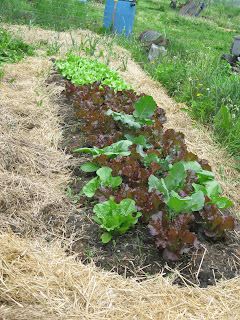It occurred to me yesterday that I should say just a bit more about canada thistle. I think a lot of people around here have to deal with this weed. I know that it's in a lot of city parks and "naturalized" areas around Ann Arbor. From what I've seen, they don't have a clue how to deal with it. The best I've seen so far is to rip it up and put down a thick layer of mulch. Which would work, if you came back and ripped it out every 3-4 weeks. Which they don't.
Canada thistle is a persistent, perennial weed. You can kill the top - have to in fact, to make any progress - but that doesn't kill the plant. You can kill the top and rip up most of the roots (good luck with that), but unless you get all the roots, you probably haven't killed the plant. You can even spray it with nasty herbicides and you haven't killed it. This is one of those plants that are a bane to the chemical farmers as well as organic farmers.
So how do you kill it? You starve it to death. You can think of it as strangling it, beating it over the head with a rock, and drowning it - it's a little more satisfying to think of it that way, though have fun putting your hands on it; the spines make it through long pants somehow. Ouch. But in reality, the way to get rid of it is by starving it.
I know of three general ways to do that. First, you can mow it. And mow it. And mow it again. After several years of mowing, it will supposedly give up the ghost.
Next, you can mow it and smother it. This is supposed to be a really good option, though I'm not so sure yet. In this method, you plant some really persistent, annual, smother crop. Sudan grass is supposed to be good. Then you mow it several times over one season, and in the end the thistle is supposed to be gone. Did you notice that "supposed" word popping up a lot? That's because alfalfa is also "supposed" to be able to do this smother crop role, and our alfalfa has a good bit of canada thistle in it. I think the alfalfa might be winning, but it's hard to be sure. We also tried the sudan grass route last year, and ended up with a spotty stand of sudan grass and tremendous piles of cut grass gumming up our sicklebar mower.
Finally, the method that I *know* works. You can clean cultivate. Clean cultivation is an anachronism from the distant past, and an abomination to good soil management, but it does get rid of the thistle, in about two months. Two months of good growing season, unfortunately. And it also breaks down an unfortunate amount of soil organic matter. And there's nothing stopping the thistle coming back from an adjacent field the next year, either. But clean cultivation - killing everything in the field every three weeks for at least three iterations, does work. We did this with sweeps on a cultivator, but I suppose the chemical farmers would blast the field with herbicide each time.
In this kind of situation, it usually makes sense to step back and re-think the problem. The proper organic solution is to say, "Doesn't something eat this weed? Is there some practice I can use to deal with it in the long-run? How can I prevent it coming back? What level of infestation can I tolerate?" Let's do these backward. Any level of infestation is a problem, because a low level *very* quickly becomes a larger infestation. As far as I can tell, the ways to prevent it coming back are to compost manure, and ruthlessly kill the thistle whenever you see it. I suspect the best practices are to improve soil tilth (it likes compacted soils), compost any manure, and ruthlessly kill the thistle whenever you see it.
Finally, "doesn't something eat this weed?" There's the rub. In its native range, this weed, like so many others, is a minor pest. It *does* have predators. However, like so many of these invasives, you don't get to use the predators. That's because so far, the three or four predatory bugs seem to like native thistles about as much as, or more than, canada thistle. Supposedly in some parts of the country they are using some of these beetles, but as of last year, they were banned in Michigan.
